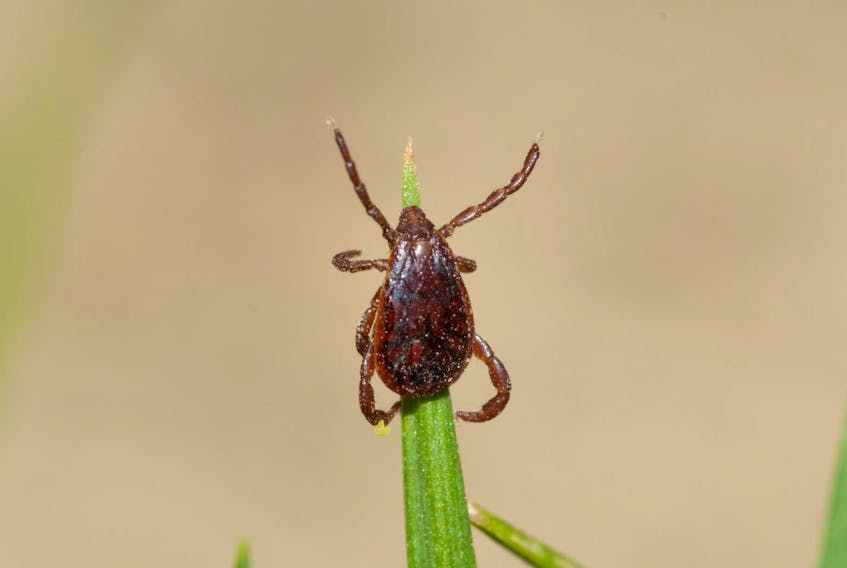PICTOU, N.S. — People are suffering from something real, and are looking for an explanation Dr. Ryan Sommers told Pictou municipal councilors on July 15.
Sommers was at Monday’s council meeting to give a presentation on the province-wide issue of Lyme disease, a bacterial infection which is transmitted by the black-legged tick.
Sommers' presentation was to bring councilors up to speed on the Nova Scotia Health Authority’s understanding of the disease and on the best ways to prevent it.
“We’re not alone in this battle,” said Sommers, a family physician and Regional Medical Officer for the Nova Scotia Health Authority’s Northern Zone. “Ottawa, Toronto, St. John, Winnipeg, Victoria and Calgary are all places that are dealing with issues of more and more cases of the ticks carrying Lyme disease.”
Lyme disease is caused by a bacterial infection that is transmitted by the blacklegged tick which, over the last fifteen years, have established themselves across most of mainland Nova Scotia.
“As temperatures increase, we get warmer weather and it allows for the dispersion of ticks on new hosts. As we look at the number of human cases of Lyme Disease as it increases up our coasts we’re expecting this to spread further as well,” Sommers told council.
No one knows this better than Charlie Strickland who was at council on July 15. Strickland is the search director of the Pictou County Volunteer Ground Search and Rescue.
“We go all the places that they tell you not to go,” Strickland said. “If you read about ticks, you know that when you’re hiking in the woods you’re supposed to go in the middle of the trail, not in the high grass. Well, we’re on a compass course and we’re going to go wherever the search takes us.”
He said he was there to hear from Sommers about what’s being done for both tick prevention and treatment for the people he knows who have Lyme Disease.
“Obviously prevention is best,” said Strickland who is also the chair if the Nova Scotia Ground Search and Rescue safety committee. “The concern we have is that right now the numbers of people with Lyme Disease is increasing.”
The focus of Sommers’ presentation was on prevention.
“The biggest thing you can do is tick checks and prevent attachment,” he said. For individuals, the message has been the same: tuck pant legs into socks, wear light clothing, cover exposed skin.
Strickland told The News that volunteers with ground search and rescue will use duct tape to fasten the bottom of their pants to the tops of their boots when walking off-trail.
Human vaccines for preventing Lyme disease are not yet available. A vaccine called LYMErix was approved by the American Food and Drug Association in 1998 and it was shown to be preventative in 90 percent of the people vaccinated. Unfortunately, the company making LYMErix stopped production after a now de-bunked article in the journal Lancet falsely linked vaccines for treating measles mumps and rubella to autism.
“But there is actually some work being done in a French lab that’s moving forward on trials,” said Sommers. “From a preventative perspective that is huge.”
On a municipal level, Sommers encouraged planners to create “buffer zones” in local green areas that would prevent the types of plants from growing which would attract animals that potentially carry ticks. That, plus continue education of the public and municipal staff were also measures being encouraged to prevent infection.
“It was a very good information session and Dr. Sommers did an excellent job,” said Strickland, “but there really isn’t much new to offer for treatment.”
This is a big issue in our health system
Current lab testing methods approved by the Centre for Disease Control and accepted by the Infectious Diseases Society of America and the Nova Scotia Health Authority test for the antibodies which people’s immune systems produce in response to an infection.
Since this immune-system response can take between 6-7 weeks to kick-in, current medical practice in Nova Scotia relies on the signs and symptoms and history of the patient.
But with Lyme Disease, Sommers said this can be particularly challenging.
“Lyme disease is actually quite challenging to make the diagnosis,” said Sommers during an interview with The News. “A lot of the initial symptoms, especially if you can’t see a rash, can overlap with other types of conditions and viral or bacterial infections.”
The characteristic “bullseye rash” associated with Lyme infection is not always easy to spot, and according to Sommers between 20 and 30 per cent of people diagnosed with Lyme disease will not remember seeing one.
“Then a couple of weeks later the can go to a second stage of the disease, usually weeks or months after the initial bite and they get these multiple rashes,” he said. “They can also get nervous system symptoms. Sometimes they’ll get arthritis that will go from one joint to another and in various rarer cases it effects their hearts.”
“The challenge is that with people who have non-specific symptoms they can overlap with other types of problems,” said Sommers.
“This is big issue in our health system. There’s over a million Canadians who have non-specific symptoms without a specific diagnosis. It can be multiple sclerosis, is can be ALS, it can be chronic fatigue syndrome. So, it’s challenging because our system isn’t designed to effectively address these people because they don’t fit in a nice little box anywhere.”

Amy Hayne-Desjardins speaking with Dr. Sommers outside of Pictou Municipal Council Chambers on July 15.
Sommer’s visit was prompted by a presentation given to Municipal council on June 17 by Amy Hayne-Desjardins and Jennifer MacLean.
Both women from Pictou County have organized a seminar in September in which they will be bringing in three doctors from the United States who follow treatment guidelines for Lyme Disease that are outside of the CDC and IDSA, and they were both there on July 15 asking Sommers and his colleagues in Nova Scotia to attend.
"We feel that Sommers will quickly identify that there is a gap in knowledge between us and the states and will do his best to understand why we are going to such lengths to widen the understanding of this extremely dangerous and infectious disease," wrote Hayne-Desjardins and MacLean in a statement to The News.









